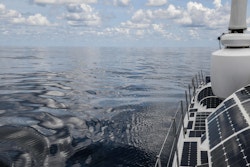Review of the 15,000 nautical miles of navigation in 2021
2021 was the year of the longest crossings of our Odyssey, against the backdrop of a global context still weakened by the health crisis. We sailed more than 15,000 nautical miles, a record distance in one year of operation for our vessel.
Our crew has weathered many storms, but our energy mix has enabled us to get through them to reach our destination.

Legendary crossings
Departure from Martinique in February 2021 for our vessel, which has set course for the Panama Canal! A crossing between two oceans with the Galapagos archipelago in sight, a refuge of biodiversity and the first major stage of 2021. Our zero-emission catamaran has been authorized to sail in certain areas, which are usually forbidden to regular ships.
We then sailed back to California, before starting a Pacific crossing with a stopover in Hawaï halfway. The port of Noumea in New Caledonia marked the end of our Pacific crossing, before starting our last leg of the year: reaching Indonesia and the port of Kupang for mid-December, with a passage through the mythical Great Barrier Reef and the Torres Strait.
Hydrogen put to work
The Pacific Ocean is the largest ocean on earth, covering about one third of the globe's surface. Our ship had to cover a distance of about 10,000 kilometres with some trying weather episodes and a test of our energy autonomy over very long distances without seeing land.
At the departure from Martinique, the wind was there and the Oceanwings® offered us great sensations with an average speed close to 10 knots!
This performance was then undermined by the lack of sunshine and wind, forcing us to draw generously on our hydrogen reserves.
Our fuel cell has never been used as much, and our ship reached Hawaï with almost empty tanks. The continuation to New Caledonia saw a better balance between our different energies, notably with the contribution of our Oceanwings® and a more regular sunshine. Even when 70% full for this second half of the transatlantic, our hydrogen tanks have duly fulfilled their role as the best ally of renewable energy!
At the end of the last navigation towards Indonesia, the lack of wind coupled with the strong heat created a significant cloudiness, precipitating the formation of storms at sea... enough to prevent our captain from sleeping for several days!
